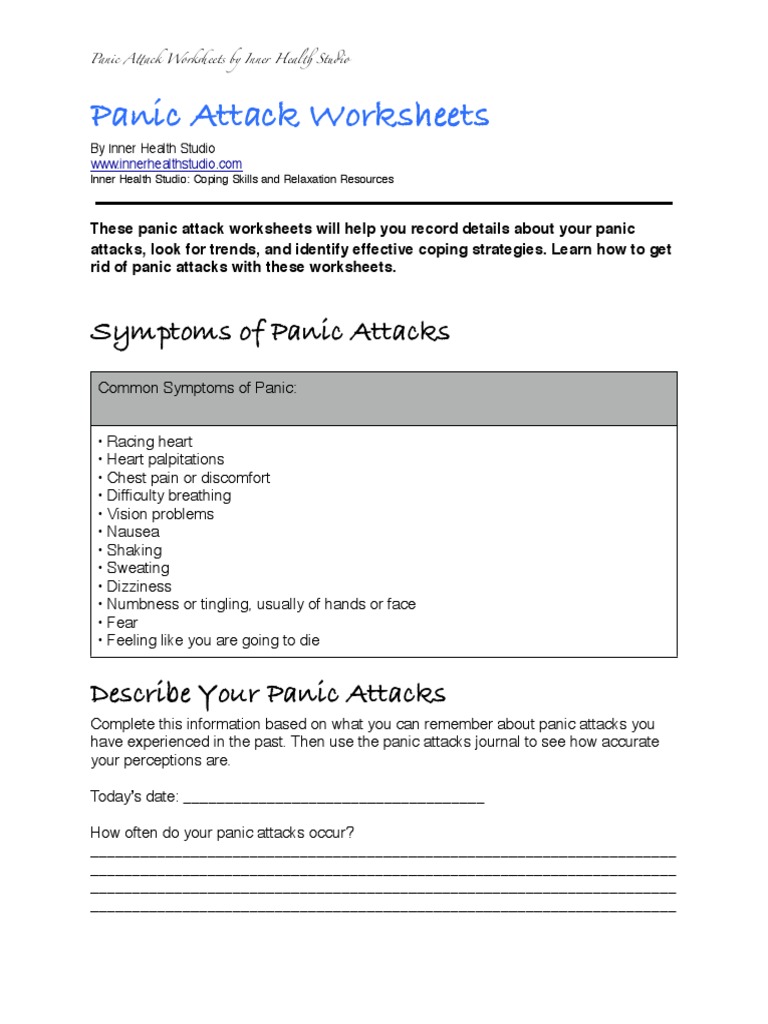CBT Worksheets to Manage Panic Attacks Effectively

In today's high-stress world, many individuals grapple with anxiety and panic attacks. These episodes can be overwhelming and disorienting, often catching one off guard. Cognitive Behavioral Therapy (CBT) offers a beacon of hope, providing tools like worksheets to manage these attacks effectively. This blog post delves into how CBT worksheets can be instrumental in understanding, coping, and ultimately overcoming panic attacks.
What are Panic Attacks?

Panic attacks are sudden episodes of intense fear that trigger severe physical reactions when there is no real danger or apparent cause. Here are some common symptoms:
- Shortness of breath
- Rapid, pounding heartbeat
- Sweating
- Trembling or shaking
- Chest pain
- Feeling dizzy or faint

The image above shows the typical physical and psychological manifestations of a panic attack.
Introduction to CBT Worksheets

CBT is grounded in the principle that thoughts, feelings, and behaviors are interconnected. By altering one, you can influence the others. Here’s how worksheets play a role:
- Identifying Cognitive Distortions: Worksheets help pinpoint irrational thoughts or cognitive distortions that contribute to panic attacks.
- Creating New Patterns: Through repeated practice, individuals learn to replace negative thoughts with more balanced or positive ones.
- Practical Application: Worksheets provide a structured way to apply CBT techniques during a panic attack, offering a sense of control.
Key CBT Worksheets for Panic Attacks

Here are some essential CBT worksheets tailored for managing panic attacks:
Panic Attack Diary

This worksheet helps track:
- The circumstances leading up to the attack.
- Physical sensations experienced.
- The thoughts that were present.
- The strategies used to cope.
Regularly completing a Panic Attack Diary allows individuals to:
- Observe patterns in triggers.
- Reduce the frequency of attacks by preemptively managing triggers.
📝 Note: It’s beneficial to review this diary periodically with a therapist to identify triggers and plan interventions.
Thought Challenging Worksheet

During a panic attack, thoughts can spiral out of control. Here’s how to use this worksheet:
- Identify the Thought: Write down the automatic, negative thought during the panic attack.
- Evaluate Evidence: Assess the evidence for and against this thought.
- Reframe the Thought: Formulate a more realistic, balanced thought to replace the negative one.
The following table illustrates an example of a thought challenging process:
| Negative Thought | Evidence For | Evidence Against | Reframe Thought |
|---|---|---|---|
| I’m going to die. | Heart is racing. | Doctors have confirmed my heart is healthy; I’ve had many attacks and survived. | I am experiencing a panic attack; my heart is fine; this feeling will pass. |

Exposure and Desensitization Worksheet

Facing anxiety-provoking situations in a controlled manner can reduce the intensity of panic attacks. This worksheet guides individuals through:
- Creating a hierarchy of anxiety triggers from least to most fear-inducing.
- Gradual exposure to these triggers, practicing coping techniques along the way.
Example:
- Low Fear: Thinking about crowded places.
- Medium Fear: Watching a video of a crowded place.
- High Fear: Visiting a crowded place in person.
🛈 Note: Ensure exposure is done gradually and with the support of a therapist if possible to avoid overwhelming oneself.
Mindfulness and Grounding Techniques

Worksheets on mindfulness and grounding can help bring focus back to the present moment, reducing the intensity of a panic attack:
- 5-4-3-2-1 Grounding: Acknowledge 5 things you see, 4 you feel, 3 you hear, 2 you smell, and 1 you taste.
- Breathing Exercises: Worksheets guide individuals through diaphragmatic breathing to calm the nervous system.
Positive Affirmations

Positive affirmations can shift focus from negative to empowering thoughts, using statements like:
- “I am in control of my emotions.”
- “I can handle this panic attack.”
Final Thoughts

CBT worksheets are powerful tools for those seeking to manage panic attacks. By regularly engaging with these worksheets, individuals can:
- Gain insight into the triggers and responses of their panic attacks.
- Develop and practice coping mechanisms that work for them.
- Reduce the intensity and frequency of panic attacks through consistent application of CBT techniques.
The process of mastering these techniques involves:
- Committing to self-observation and understanding.
- Repeating and refining coping strategies.
- Working with a mental health professional to optimize personal recovery.
Remember, managing panic attacks through CBT is a journey, not an instant fix. Patience, persistence, and professional guidance can pave the way to reclaiming control over one’s life from the grip of panic.
How often should I use CBT worksheets for panic attacks?

+
Ideally, daily practice is most beneficial, especially when initially incorporating CBT techniques into your routine. Consistency is key to reinforcing new thought patterns and coping mechanisms.
Can CBT worksheets replace therapy sessions?

+
While CBT worksheets can significantly help manage panic attacks, they are not a substitute for professional therapy. A therapist can provide personalized guidance, emotional support, and modify treatments as needed.
Are these worksheets suitable for all ages?

+
CBT worksheets can be adapted for different age groups, though versions for children often include simplified language and activities more suitable for their developmental stage. It’s always best to consult with a professional for age-specific guidance.



